Plant Health Care & Pest Control
Prevention is crucial! Healthy Trees and Shrubs increase property value. Save your trees and shrubs from costly pruning, removals and pest damage by being proactive with plant healthcare (PHC).
If you have concerns about your plants’ health, we recommend taking samples to Ellington Agricultural Center for testing (a $15 service that tests and recommends treatment). Our owner, Jeff Bergman, a licensed and certified pesticide applicator, is also available for paid consultations for diagnoses and to devise treatment plans.
At Full Circle Tree and Shrub we believe that PHC is one of the most important and most overlooked aspects of horticulture. Not surprisingly, it is less expensive to keep a tree healthy than it is to treat a diseased tree. There are also many common pests in the Middle Tennessee area that we can be prevented and treated as well.
Common Tree Treatments
Mycorrhizae Treatments. During planting and landscaping projects, we can apply mycorrhizae to the soil. This helps plants become established more quickly and cuts down on transplant stress. Healthy trees can be treated annually for prevention, whereas sick trees will require seasonal treatments.
A Mycorrhiza (plural: Mycorrhizae) is a fungus that naturally occurs in the soil and results from a symbiotic relationship with plant roots. The fungi help roots extract nutrients from the soil and, in return, the plant provides the mycorrhizae with sugars produced by photosynthesis. Once mycorrhizae colonize the roots of a plant, it grows throughout the soil forming an extensive cobweb-like network. This network is able to explore a larger soil volume than normal roots. This highly intelligent root system greatly reduces drought stress and, by increasing the surface area, makes it harder for fungal and bacterial diseases to attack. Mycorrhizae is critical to most plants used in landscaping. Without them the world would look much less colorful.
Reduces: drought stress, water and fertilizer needs, disease, transplant shock
Increases: flowering & fruiting, water & nutrient uptake, root growth
Promotes: healthy root system, soil structure, strong plant establishment
**Systemic Insecticide can also be added to our mix to treat insect problems such as: Woolly Aphid, Azalea Lacebug, & Boxwood Leafminer
Common insects for annual treatment:
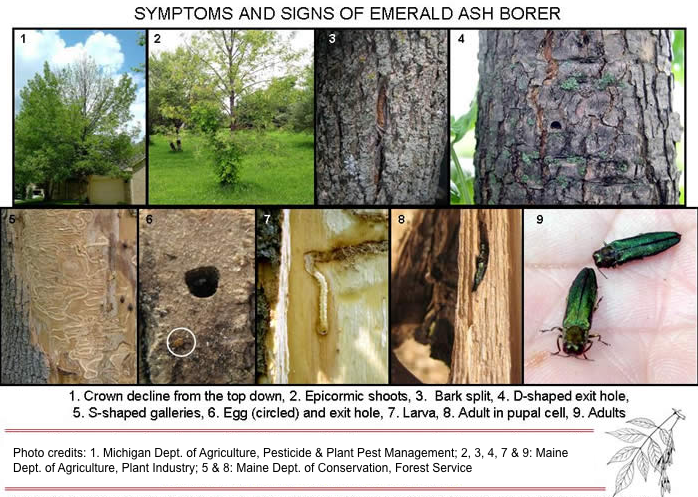 Emerald Ash Borer. A pest plaguing our trees in Middle Tennessee is E.A.B. This insect attacks our ash trees and has been wiping out the ash population from the northeast to the central states since first being discovered in Michigan in 2002. This pest was first detected in Tennessee in 2010 in Knox County. Since that time, it has spread to 47 counties throughout East and Middle Tennessee, including Davidson Co. in 2014 and most recently Wilson Co. Unfortunately by the time a tree shows symptoms it is typically too late to save the tree. For Ash trees, prevention is key, so treat all trees in your landscape that you want to save! For more information, please visit our EAB page. We offer one- and two-year treatment options.
Emerald Ash Borer. A pest plaguing our trees in Middle Tennessee is E.A.B. This insect attacks our ash trees and has been wiping out the ash population from the northeast to the central states since first being discovered in Michigan in 2002. This pest was first detected in Tennessee in 2010 in Knox County. Since that time, it has spread to 47 counties throughout East and Middle Tennessee, including Davidson Co. in 2014 and most recently Wilson Co. Unfortunately by the time a tree shows symptoms it is typically too late to save the tree. For Ash trees, prevention is key, so treat all trees in your landscape that you want to save! For more information, please visit our EAB page. We offer one- and two-year treatment options.
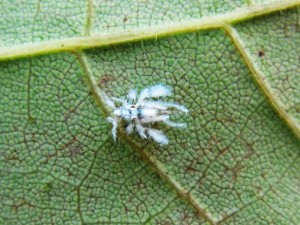 Hackberry Woolly Aphid (can also affect maples and crape myrtles). Are you tired of all that sticky stuff on your cars & decks in the Fall? That is not sap coming from your Hackberry trees — it is the excrement from a little pest called Woolly Aphid. This aphid produces copious honeydew excretions upon which blackish, sooty mold grows creating a sticky mess on leaves and surfaces beneath infested trees. While no long-term or serious damage to hackberry trees has been found after years of aphid infestations, insecticides are not needed to protect the health or survival of infested trees; rather, they are applied when honeydew excretions are intolerable to people! If we treat your trees in the Spring, we can prevent Hackberry woolly aphid from hatching in the first place, saving you money on car washes and pressure washing your decks & driveways. Depending on its size, typically a Hackberry is anywhere from $75-$200 to treat. However, if there are numerous Hackberries in your neighborhood or surrounding your property, treating just one tree will not help. Look for neighborhood group rates to treat all trees in the area and increase the effectiveness of the treatment.
Hackberry Woolly Aphid (can also affect maples and crape myrtles). Are you tired of all that sticky stuff on your cars & decks in the Fall? That is not sap coming from your Hackberry trees — it is the excrement from a little pest called Woolly Aphid. This aphid produces copious honeydew excretions upon which blackish, sooty mold grows creating a sticky mess on leaves and surfaces beneath infested trees. While no long-term or serious damage to hackberry trees has been found after years of aphid infestations, insecticides are not needed to protect the health or survival of infested trees; rather, they are applied when honeydew excretions are intolerable to people! If we treat your trees in the Spring, we can prevent Hackberry woolly aphid from hatching in the first place, saving you money on car washes and pressure washing your decks & driveways. Depending on its size, typically a Hackberry is anywhere from $75-$200 to treat. However, if there are numerous Hackberries in your neighborhood or surrounding your property, treating just one tree will not help. Look for neighborhood group rates to treat all trees in the area and increase the effectiveness of the treatment.
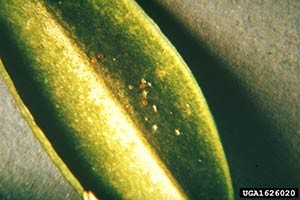 Spider mites. These pests cause damage to many different plants. We usually see this type of foliar damage on laurels, boxwoosd and other trees and shrubs. This type of damage can compound yaer after year and eventually not only the apperance of the tree/shrub becomes compromised but the overall heath of the pland can deteriorate. PHOTO: http://www.forestryimages.org/browse/detail.cfm?imgnum=1626020
Spider mites. These pests cause damage to many different plants. We usually see this type of foliar damage on laurels, boxwoosd and other trees and shrubs. This type of damage can compound yaer after year and eventually not only the apperance of the tree/shrub becomes compromised but the overall heath of the pland can deteriorate. PHOTO: http://www.forestryimages.org/browse/detail.cfm?imgnum=1626020
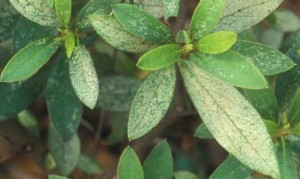 Azalea lacebug. These pests can cause not only aesthetic damage, but also can stress your plant to the point of limited flowering and ultimately death.
Azalea lacebug. These pests can cause not only aesthetic damage, but also can stress your plant to the point of limited flowering and ultimately death.
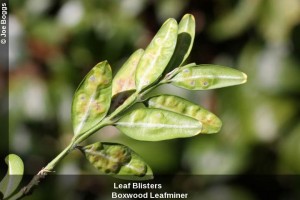 Boxwood leafminer and spider mites. These are two of the most destructive insects to attack boxwoods. In this picture we see the blistering of the leaf as the miners eat the plant material between the upper and lower portions of the leaf.
Boxwood leafminer and spider mites. These are two of the most destructive insects to attack boxwoods. In this picture we see the blistering of the leaf as the miners eat the plant material between the upper and lower portions of the leaf.
Scale. Occurring on many plants including Yews, Maples, Magnolias and Oaks to name a few, Scale are a little more difficult to control due to the waxy substance they produce to protect themselves from predators. Scale-damaged plants look withered and sickly. Leaves turn yellow and may drop from the plant. They may also have sticky sap or a black fungus on the leaves and stems. Heavily infested plants produce little new growth. Systemic insecticides are usually the most effective treatment but foliar sprays can also be used. PHOTO: http://www.forestryimages.org/browse/detail.cfm?imgnum=5388263
Contact Us to set up a plant healthcare consultation.
Get a Quote NowPlant Healthcare involves many things including…
-
- Proper Pruning: This ensures that a tree will grow and thrive in a proper manner and won’t interfere with other trees and plants.
- Diagnosing Disease: There are many different diseases and fungus that can affect trees and shrubs. Recognizing and treating them can be handled by a certified arborist.
- Treatment of Insect and Disease Issues: Insect infestations and disease can occur quickly and can kill hundreds of trees in a short period. Early detection and mitigation of dangerous insect problems and disease is crucial.
- Root Health: A tree’s root system is often an afterthought but is crucial to the health and longevity of the tree as a whole
- Soil Issues: Proper soil is composed of well proportioned amounts of silt, sand and clay as well as an appropriate pH level and other factors. Unfortunately, many urban areas have less than ideal soil for trees and plants to thrive in. Testing and soil amendments can resolve most issues.
